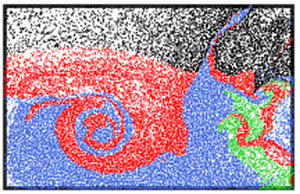Article contents
On the lifespan of recirculating suspensions with pulsatile flow
Published online by Cambridge University Press: 04 October 2021
Abstract

A Lagrangian analysis is performed to measure the rate at which recirculating fluid is replaced (depleted) in pulsatile flows. Based on this approach, we then investigate how depletion is affected in dense suspensions. Experiments are conducted for pure liquid as well as suspensions with volume fractions of  $\varPhi =5\,\%$, 10 % and 20 %. Using Lagrangian tracking and pathline extension techniques, the depletion of the recirculation region is quantified via the trajectories of individual fluid parcels exiting the domain. Pulsatile flows with varying concentrations of hydrogel beads, up to a volume fraction of 20 %, are compared at mean Reynolds numbers of
$\varPhi =5\,\%$, 10 % and 20 %. Using Lagrangian tracking and pathline extension techniques, the depletion of the recirculation region is quantified via the trajectories of individual fluid parcels exiting the domain. Pulsatile flows with varying concentrations of hydrogel beads, up to a volume fraction of 20 %, are compared at mean Reynolds numbers of  $Re=4800$, 9600 and 14 400, while the Strouhal number (
$Re=4800$, 9600 and 14 400, while the Strouhal number ( $St=0.04$, 0.08 and 0.15) and amplitude ratio (
$St=0.04$, 0.08 and 0.15) and amplitude ratio ( $\lambda =0.25$, 0.50 and 0.95) are systematically varied. A so-called ‘depletion efficiency’ is calculated for each test case, which is shown to increase with increasing Strouhal number and amplitude ratio. For most pulsatile cases, periodic vortex formation significantly increases depletion efficiency through enhanced entrainment of recirculating fluid. Conversely, low-amplitude pulsatile flows are dominated by Kelvin–Helmholtz instabilities, which do not penetrate into the recirculation region, and thus their depletion efficiency is markedly lower as a result. The efficiency trends and depletion mechanisms remain virtually unchanged between the pure liquid and each of the suspension concentrations under almost all flow conditions, which forms an unexpected conclusion. The only exception is for low-amplitude and steady flows, where increasing the suspension volume fraction is shown to suppress fluid transport across the shear layer, which in turn slows depletion and decreases the overall depletion efficiency.
$\lambda =0.25$, 0.50 and 0.95) are systematically varied. A so-called ‘depletion efficiency’ is calculated for each test case, which is shown to increase with increasing Strouhal number and amplitude ratio. For most pulsatile cases, periodic vortex formation significantly increases depletion efficiency through enhanced entrainment of recirculating fluid. Conversely, low-amplitude pulsatile flows are dominated by Kelvin–Helmholtz instabilities, which do not penetrate into the recirculation region, and thus their depletion efficiency is markedly lower as a result. The efficiency trends and depletion mechanisms remain virtually unchanged between the pure liquid and each of the suspension concentrations under almost all flow conditions, which forms an unexpected conclusion. The only exception is for low-amplitude and steady flows, where increasing the suspension volume fraction is shown to suppress fluid transport across the shear layer, which in turn slows depletion and decreases the overall depletion efficiency.
- Type
- JFM Papers
- Information
- Copyright
- © The Author(s), 2021. Published by Cambridge University Press
References
REFERENCES
- 1
- Cited by





